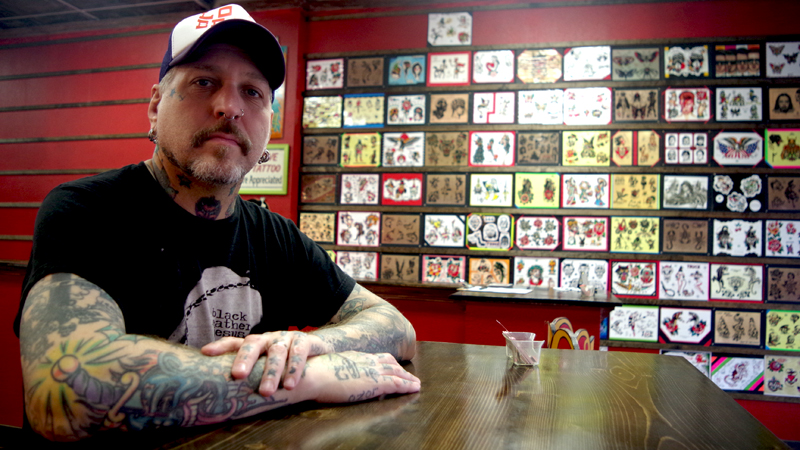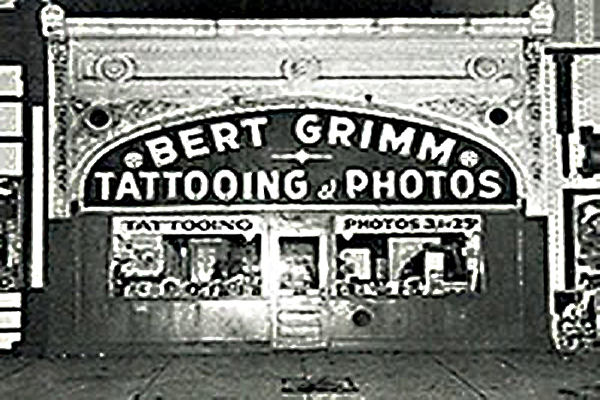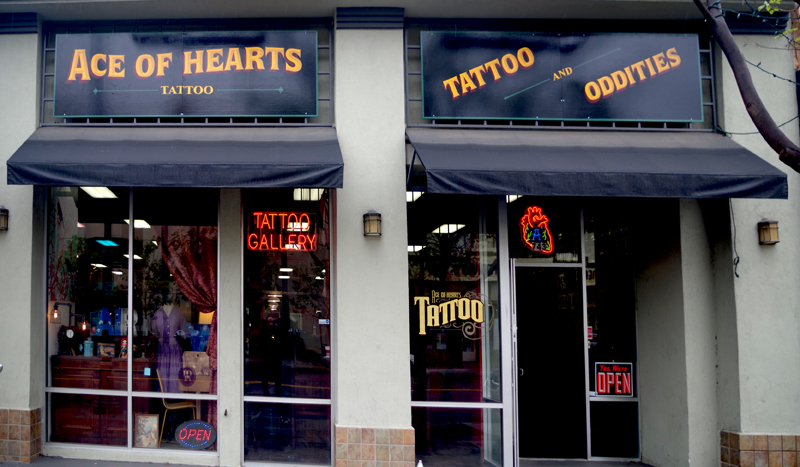
Joe Truck, owner of Ace of Hearts. Photo by Sander Roscoe Wolff.
Joe Truck is a tattoo artist, musician, and entrepreneur who recently opened Ace of Hearts, the first tattoo studio on Pine Avenue, located in the Bungalow Building just north of 7th Street. Truck is steeped in the history of local tattooing, and opened the first legal street shop in New York City back in the mid-90s.
Long Beach Post: What prompted you to consider opening a shop in downtown Long Beach?
Joe Truck: Well I always wanted to have a shop in Long Beach. My father worked as a carnival pitchman with Anton Lavey at The Pike for a while. I knew the tattoo history here, and loved the city. I moved here in 1996 and approached the city and they basically said they were trying, at that point, to eradicate tattooing from the Long Beach landscape, so was forced to open in San Pedro.

What is that history?
The Pike is/was the oldest running tattoo shop in the U.S. Bert Grimm, Bob Shaw, and eventually Rick Walters are all part of the great history of our art. Sailors would line up at the Pike on leave and thousands of tattoos would pour out of the shop. All still looking pretty good, even now, I must say. I’ve photographed a ton of them around town. The tattoo history here is pretty deep.
Tell me about San Pedro. You opened a shop there. What was that like?
I opened a shop in 1997 on Pacific and 3rd, called Alphabet City West. This was a reference to my existing shop, Alphabet City, back in New York that I still owned at the time. It was a large space, but tattooing around the South Bay hadn’t really taken off. After a year I closed it and went to work for another shop.
Do you remember your first tattoo?
Yes. My first tattoo that I got was in 1979. It was a huge dragon on my arm by a fellow by the name of Don Singer. Only Bob Roberts could remember him, as far as I know. When I was a child I lived in Greenwich Village in New York. This was the 1960s, so there were always hippies, criminals, and biker gangs everywhere. I became obsessed by, and drawn to, the outlaw/outsider element, and they all had tattoos! Also, I was always an artist.
Honestly, I really loved Brian Setzer, pre Stray Cats. He had a bunch of large pieces done by Bob Roberts, who was still living in NYC at the time. He had a band called the Bloodless Pharaohs. So cool. Sounded like a gang. They were tattooed, as were all the musicians I hung out with in 78 and 79.
You said that you were an artist. When did that start?
I had a bad childhood, so art was my escape. I would draw, and listen to music, to drown out the tension and the fighting in my life. I went to the Music and Art High School, and was in the Art Students League. Artist kids like to smoke weed and party! [laughs] We did a lot of graffiti writing, cutting class, riding the trains, and going to grindhouse and porn movies on 42nd Street. All that was fodder for my future art endeavors. It was a very creative atmosphere.
How did you decide that tattooing was the career path for you?
I was collecting tattoos since 79 and, by 1991, I was jumping from one job to the next being a musician. I was working at a photography studio and had been getting tattooed by the wonderful man who would end up as my mentor: Sean Vasquez. My manager was also heavily tattooed, and she suggested I start tattooing myself. In 1992, this was not done! Getting an “apprenticeship” was next to impossible, but I approached Sean and he said yes, but it would have to be a secret.
Why a secret?
You just didn’t give anyone the secrets of tattooing, back then. It was a secret society. In the early 90s there were probably 200 tattooers in the whole country! They realized, even then, that it would end up like it has.
What was the process, then, for someone who wanted to join the ranks? You mentioned apprenticeships. Why were they so hard to come by?
It was like being a biker club prospect. Basically, slave for a year or two before you even got to touch a tattoo machine. Sean had to let me go before we were finished because of pressure from some pretty famous tattooers. So, I was left on my own.
I started tattooing (not very well) and went around with a small portfolio to try to get a job at the five or six shops that existed in NYC at the time. All doors slammed in my face, so I did the only thing I could do. I opened a private studio on Avenue C and 4th Street, began tattooing, and it took off. That caused a ruckus.
You admitted that you were inexperienced. What caused your private studio to take off?
I am told I have the gift of gab. At that time most tattooers were tough, rude, curt to say the least. They didn’t have to be “nice” to people. There was no “customer service.” You came, got tattooed, and that was it. Intimidating? Yes, but if you wanted a tattoo you dealt with that. I had amazing customer service. I was nice to people. I talked to them, smiled, and helped them out. That was one part of it.
Also, the spot I picked was a block away from Thom De Vita’s old studio, and he had just left town, so I got his entire clientele. Add to that that I was also a well known musician and, bang! Lines around the corner. I broke the rules and it paid off, but I still respected the art and artists who came before me! I revered them. I still do.
Let’s talk, for a moment, about your parallel career as a musician, which is something you still pursue. How did that get started?
I was always a fan of all types of music, but rock is where my heart is. I started out playing in punk bands at Max’s Kansas City and CBGB in the late 70s.
The scene, then, must have been insane.
It was blowing up. It was the best. The late 70s and early 80s in NYC was absolutely sublime. I’d have drinks with Basquiat after a show. {laughs] The artists, poets, rockers. I shared the stage with Johnny Thunders. It was amazing. I was in Scarecrow (the first goth band in NYC), Chop Shop, Braineaters (with Damien from Samhain), and so many others.
Your tattoo studio was popular. What happened next?
Tattooing had been illegal in NY since 1961. I was approached by some people in the industry to see if we could get it legalized. Since I was the first person to advertise, even though it was illegal, I agreed. This was probably 1995.
We pushed through a bill to lift the tattoo ban and, since I had the inside track on things, I already had my first “street shop” ready to go on Avenue A and 14th St. The day the ban was lifted, I opened the first legal street shop in New York!
How did that change the business for you, and the others working in the city?
Originally, I thought the city would make it hard for new shops to open, and it would be good for us, but I was wrong. It destroyed the city as far as tattooing goes. People from other states flooded in, opened shops, and now its the completely over-saturated tattoo city that exists today. I’m really hoping and praying that Long Beach is more careful in that respect. Now, there’s at least 500+ tattoo shops in NYC. More, probably.

Ace of Hearts Tattoo. Photo by SRW.
Getting back to Long Beach, how did you find your spot?
Elizabeth Kobliha, who owns Long Beach Vintage Etc., kept telling me that there was a spot open next to her, but I didn’t believe it could possibly be zoned correctly. I waited a year and then she finally convinced me to check.
What was the process like? Did it go smoothly, or were there challenges that cropped up?
The city, and the residents of the neighborhood where we are located, have been wonderful to me/us. That being said, it was a long hard road. There were many roadblocks and compliances I had to go through but, instead of getting frustrated, I just kept on keeping on. I persevered, and showed them I was a serious, experienced artist and businessman and that the shop would be a great addition to the North Pine neighborhood. The support was really amazing.
There’s been a cultural shift, in the last decade, where tattooing has become much more socially acceptable, and the information about tattooing has been more widely disseminated in popular culture. How has that affected you, as an artist?
As an artist, not at all. As a shop owner, immensely. I have been a pioneer of American traditional tattooing since the beginning of my career. That hasn’t changed. As a businessman, it has affected the business adversely because, lets face it, too many people are tattooing now. The acceptance of tattooing—because of the media—has helped a lot. I believe it’s part of the reason the City of Long Beach eased up, but they need to still keep the zoning tight! I can’t say that enough.
Ace of Hearts is located at 743 Pine Avenue. To learn more about Ace of Hearts, call 562.685.1320, or visit AceOfHeartsTattoo.com. To learn more about Truck’s current band, Circus of Power, check them out on bandcamp.

